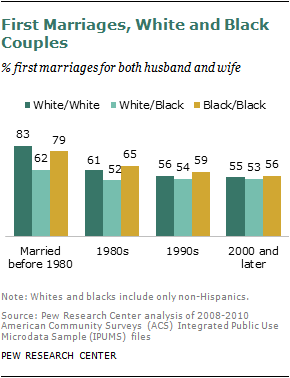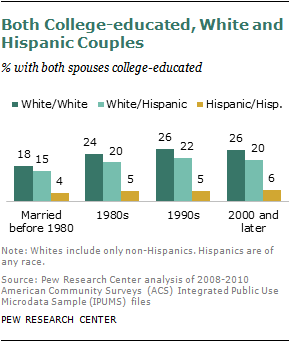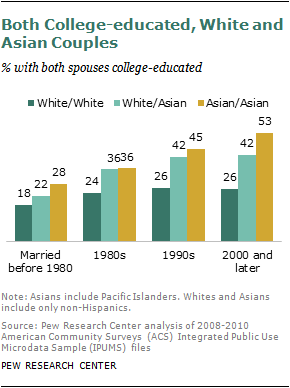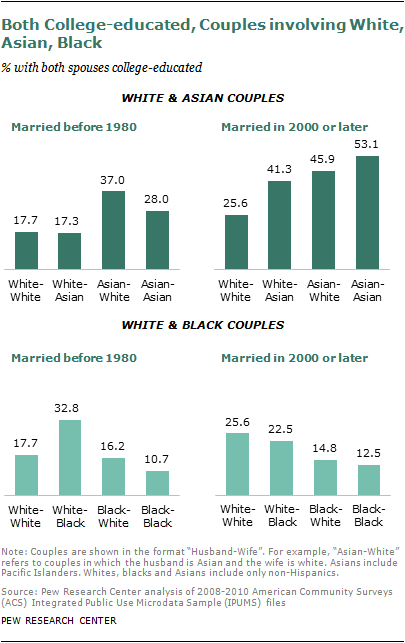To see whether the differences between newlywed intermarried couples and those who married in hold true among couples who are not newlyweds, this chapter looks at all currently married couples between 2008 and 2010, dividing them into four groups based on the time period in which the couples got married. The four cohorts of currently-married couples got married either prior to 1980, in the ’80s, in the ’90s, or in the decade that ended in 2010.
 Within each cohort, selected characteristics were compared between the couples who intermarried and those who married within their own racial or ethnic group. The purpose of the comparison is to see whether the difference between the two groups have changed over the cohorts, rather than comparing the earlier cohorts with later cohorts within each group.12 Similar to the previous chapter, the analysis starts with the overall comparison between the intermarried couples and the intra-married couples within each cohort, and then extends to specific pairs of different race/ethnicity within each cohort.
Within each cohort, selected characteristics were compared between the couples who intermarried and those who married within their own racial or ethnic group. The purpose of the comparison is to see whether the difference between the two groups have changed over the cohorts, rather than comparing the earlier cohorts with later cohorts within each group.12 Similar to the previous chapter, the analysis starts with the overall comparison between the intermarried couples and the intra-married couples within each cohort, and then extends to specific pairs of different race/ethnicity within each cohort.
Among couples who got married before 1980, inter-married couples were less likely than intra-married couples to be married for the first time (by a difference of 10 percentage points), however, the gap has narrowed over the cohorts. Among couples who married in the 21st century, it has nearly closed. About 57% of mixed couples who married in 2000 or later were married for the first time, compared with about 59% of same-group couples who married during the same period. For newlyweds in 2008-2010, the pattern has even reversed slightly.
The earning gap between intermarried and intra-married couples widens among couples who married earlier. Among couples who got married prior to 1980, intermarried couples have combined earnings of $31,000, nearly double the earnings of intra-married couples ($16,811). One related factor is the work status of couples. Almost seven-in-ten (69%) intermarried couples who married before 1980 are still working (either one spouse or both), compared with 61% of their counterparts who married in. The gap in working status is not significant among couples who married later.
Mixed couples who married prior to 1980 were slightly less likely than their counterparts who married in to be college-educated (15% vs. 17%), but the gap has closed among the couples who married in later time periods.
Couple Comparison by Cohorts
 Within each cohort, this section compares the intermarried couple with a pair of intra-married couples that either husband or wife of the mixed union could have formed if they married someone of their own group. For example, mixed white/Hispanic couples will be compared with white couples and Hispanics couples, separately.
Within each cohort, this section compares the intermarried couple with a pair of intra-married couples that either husband or wife of the mixed union could have formed if they married someone of their own group. For example, mixed white/Hispanic couples will be compared with white couples and Hispanics couples, separately.
First Marriage: Intermarried white/Hispanic couples who got married prior to 1980 are less likely than either white or Hispanic couples to be first-time married couples. Among cohorts of couples who got married after 1980, the gap between white/Hispanic couples and the white couples has closed, but the gap between white/Hispanic couples and Hispanic couples remains.
 Intermarried white/Asian couples follow a similar pattern to the white/Hispanic couples. For couples married before 1980, intermarried white/Asian couples were less likely than either white couples or Asian couples to be first-time married couples. Even though the gap between white/Asian couples and Asian couples has remained or even slightly increased in cohorts who got married in the past three decades, the difference between white/Asian and white couples has faded among recent cohorts. For couples who married in 2000 or later, white/Asian couples are even slightly more likely to be first-time married couples (57% vs. 55%).
Intermarried white/Asian couples follow a similar pattern to the white/Hispanic couples. For couples married before 1980, intermarried white/Asian couples were less likely than either white couples or Asian couples to be first-time married couples. Even though the gap between white/Asian couples and Asian couples has remained or even slightly increased in cohorts who got married in the past three decades, the difference between white/Asian and white couples has faded among recent cohorts. For couples who married in 2000 or later, white/Asian couples are even slightly more likely to be first-time married couples (57% vs. 55%).
 Similar to other mixed couples, white and black mixed couples who married before 1980 were less likely to be first-time married than white or black couples. However, the gap has narrowed over the cohorts. For couples who married in the recent decade, the differences between white/black couples and their corresponding same race couples are minimal: It was the first marriage for slightly over half of white/black mixed couples (53%), 55% of white couples and 56% of black couples.
Similar to other mixed couples, white and black mixed couples who married before 1980 were less likely to be first-time married than white or black couples. However, the gap has narrowed over the cohorts. For couples who married in the recent decade, the differences between white/black couples and their corresponding same race couples are minimal: It was the first marriage for slightly over half of white/black mixed couples (53%), 55% of white couples and 56% of black couples.
 College Education: Education levels of intermarried couples often fall between the two groups of intra-married couples corresponding to them. About one-in-five intermarried white/Hispanic couples who married in 2000 or later are college-educated. That is lower than white couples (26%) but higher than Hispanic couples (6%). A similar pattern exists among those couples who married in earlier years, but the shares are somewhat lower, especially for couples who married prior to 1980.
College Education: Education levels of intermarried couples often fall between the two groups of intra-married couples corresponding to them. About one-in-five intermarried white/Hispanic couples who married in 2000 or later are college-educated. That is lower than white couples (26%) but higher than Hispanic couples (6%). A similar pattern exists among those couples who married in earlier years, but the shares are somewhat lower, especially for couples who married prior to 1980.
 White/Asian couples also fall in between white couples and Asian couples in terms of level of education, although in a different direction. White/Asian couples are more likely than white couples to be college-educated, but less likely than Asian couples to be college-educated. The gaps between these three groups are pretty even among couples who married before 1980. The education levels of intermarried white/Asian couples and Asian couples, but not the white couples, have increased dramatically among couples who got married in more recent times. For couples who got married in the past 10 years, the share of college-educated couples among white/Asian couples is more than 1.5 times that of white couples (42% vs. 26%), and the share among Asian couples is twice that of white couples (53% vs.26%).
White/Asian couples also fall in between white couples and Asian couples in terms of level of education, although in a different direction. White/Asian couples are more likely than white couples to be college-educated, but less likely than Asian couples to be college-educated. The gaps between these three groups are pretty even among couples who married before 1980. The education levels of intermarried white/Asian couples and Asian couples, but not the white couples, have increased dramatically among couples who got married in more recent times. For couples who got married in the past 10 years, the share of college-educated couples among white/Asian couples is more than 1.5 times that of white couples (42% vs. 26%), and the share among Asian couples is twice that of white couples (53% vs.26%).
 White/black intermarried couples follow a somewhat different pattern from the other two mixed couples. Among the cohort who married before 1980, the mixed white/black couples have the highest educational attainment. About one-in-five (20%) of these couples are college-educated, compared with 18% of white couples and 11% of black couples. Yet, intermarried white/black couples who got married later are less likely to be college-educated than their counterparts who got married earlier (among three pairs of intermarriages with whites, this happens only among white/black pairs). Thus, the education gap between white/black couples and white couples has been reversed among couples who married later. About 17% of white/black intermarried couples who got married in the past 10 years are college-educated, compared with more than a quarter of white couples (26%). But regardless of when they got married, intermarried white/black couples are more educated than black couples.
White/black intermarried couples follow a somewhat different pattern from the other two mixed couples. Among the cohort who married before 1980, the mixed white/black couples have the highest educational attainment. About one-in-five (20%) of these couples are college-educated, compared with 18% of white couples and 11% of black couples. Yet, intermarried white/black couples who got married later are less likely to be college-educated than their counterparts who got married earlier (among three pairs of intermarriages with whites, this happens only among white/black pairs). Thus, the education gap between white/black couples and white couples has been reversed among couples who married later. About 17% of white/black intermarried couples who got married in the past 10 years are college-educated, compared with more than a quarter of white couples (26%). But regardless of when they got married, intermarried white/black couples are more educated than black couples.
More about Asian and Black Intermarriages
Because of the gender differences of intermarriages among Asians and African Americans, this section takes a special look at various couple combinations (husband/wife specific) between these two racial groups and whites by cohort.
 College Education: Among all white and Asian couples who got married before 1980, Asian husbands who marriedwhite wives have the highest education level. In nearly four-in-ten (37%) couples in this group both the husband and wife are college-educated, compared with 28% of Asian couples, 18% of white couples and 17% of white husband/Asian wife couples. However, among the cohort who got married in the recent decade, same-race Asian couples have the highest education; more than half (53%) are college-educated. The pair of Asian husband/white wife ranked second (46%), then white husband/Asian wife (41%). White couples have the lowest share of both husband and wife being college-educated (26%).
College Education: Among all white and Asian couples who got married before 1980, Asian husbands who marriedwhite wives have the highest education level. In nearly four-in-ten (37%) couples in this group both the husband and wife are college-educated, compared with 28% of Asian couples, 18% of white couples and 17% of white husband/Asian wife couples. However, among the cohort who got married in the recent decade, same-race Asian couples have the highest education; more than half (53%) are college-educated. The pair of Asian husband/white wife ranked second (46%), then white husband/Asian wife (41%). White couples have the lowest share of both husband and wife being college-educated (26%).
For couples involving whites and blacks, the pair of white husband/black wife who married before 1980 stands out. One-third (33%) of white husband/black wife couples who married before 1980 are college-educated, compared with 18% of white couples, 16% of black husband/white wife couples and about 11% of black couples who married during the same time period. In contrast, the more recently married white husband/black wife couples are somewhat less educated than the earlier cohort: Less than a quarter of the pair (22%) are college-educated. And their share of college-educated is also lower than white couples (26%) who married in 2000 or later, even though the white-black pair is still more educated than the black husband/white wife couple (15%) and black couple (13%).
 Age Difference: The age difference between the husband and wife is another factor that changes dramatically over different cohorts. For Asian and white couples who married before 1980, the age difference between Asian husband and white wife (3.3 years) is nearly three times as much as the difference between a white husband and Asian wife (1.2 years). However, this pattern is completely flipped among comparable couples who married in the past 10 years. The age difference jumped to nearly five years (4.8) between a white husband and Asian wife, but reduced to two years between an Asian husband and white wife. The husband-wife age differences for both white couples (2.3 years) and Asian couples (3.4 years) have been stable over different cohorts.
Age Difference: The age difference between the husband and wife is another factor that changes dramatically over different cohorts. For Asian and white couples who married before 1980, the age difference between Asian husband and white wife (3.3 years) is nearly three times as much as the difference between a white husband and Asian wife (1.2 years). However, this pattern is completely flipped among comparable couples who married in the past 10 years. The age difference jumped to nearly five years (4.8) between a white husband and Asian wife, but reduced to two years between an Asian husband and white wife. The husband-wife age differences for both white couples (2.3 years) and Asian couples (3.4 years) have been stable over different cohorts.
In contrast, the changes of age difference among different cohorts of black/white intermarried couples are less dramatic. Among couples who got married prior to 1980, the age difference is the largest for black husband/white wife couples (three years); the difference is 1.7 years for the white husband/black wife pair, 2.5 years for black couples and 2.3 years for white couples. For couples married in 2000 or later, the age difference between a white husband and black wife is three years, which is almost double the age difference for their counterparts who married earlier (1.7 years). But the age differences for other white and black couples have hardly changed.


